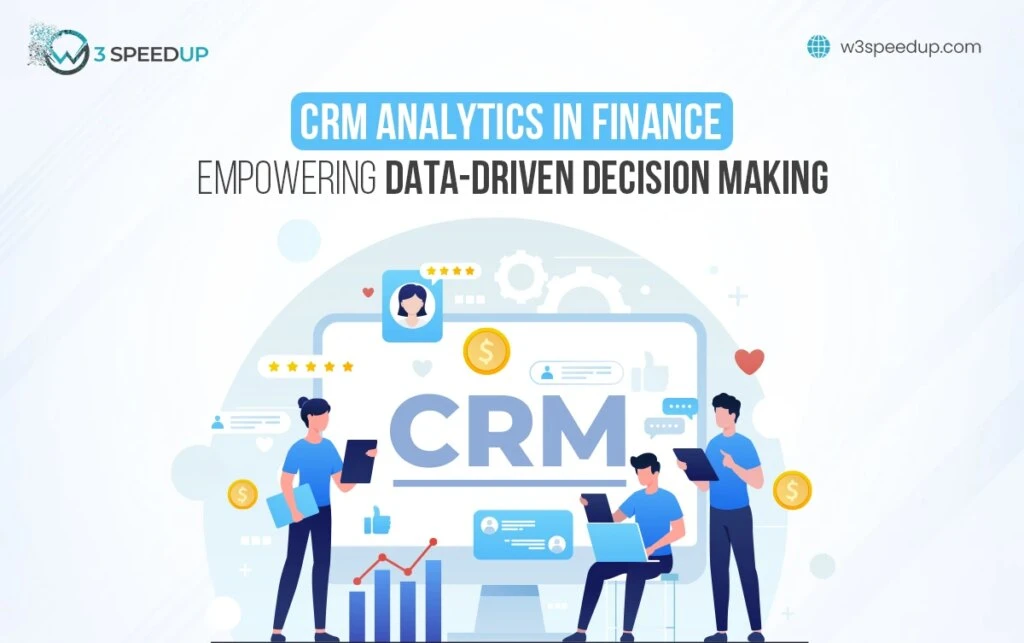In today’s rapidly evolving financial landscape, data has emerged as a critical asset for decision-making. The ability to harness vast amounts of data and turn it into actionable insights has become a competitive advantage for financial institutions. This is where Customer Relationship Management (CRM) systems play a crucial role. Modern CRM platforms come equipped with powerful analytics tools that help financial institutions understand customer behavior, predict market trends, and make informed decisions.
In this article, we’ll explore how CRM analytics can be leveraged for data-driven decision-making in the finance industry, the benefits it brings to financial institutions, and best practices for implementation. Additionally, we will examine real-world challenges and offer insights into how financial organizations can fully optimize their use of CRM analytics.
Understanding CRM Analytics in Finance
What is CRM Analytics?
CRM analytics refers to the tools and processes used within a CRM system to collect, analyze, and visualize data related to customer interactions, sales processes, marketing campaigns, and service efforts. In finance, CRM analytics enables banks, credit unions, insurance firms, and investment firms to gain a deeper understanding of customer behavior, optimize sales strategies, and streamline operations.
These systems help collect and process a variety of customer data points, including demographic information, transaction histories, communication preferences, and more. CRM analytics then generates reports and insights that support key business decisions.
Why CRM Analytics Matters for Financial Services
CRM analytics allows financial institutions to move beyond traditional, reactive decision-making processes and adopt a proactive, data-driven approach. Here’s why it’s essential:
- Personalization: Financial services are increasingly customer-centric, and CRM analytics helps institutions deliver personalized offers, tailored financial products, and better services.
- Risk Management: Financial institutions can use CRM analytics to predict and mitigate risks, such as customer churn, loan defaults, or fraud.
- Efficiency: CRM analytics improves internal processes by automating data collection and analysis, leading to faster and more accurate decision-making.
Key Data Sources for CRM Analytics in Finance
For CRM analytics to be effective, financial institutions need to collect and analyze the right data. Here are the key sources of data that fuel CRM analytics in finance:
1. Customer Demographics and Behavior
CRM systems store rich demographic data such as age, income, location, and occupation, which can be combined with behavior data (e.g., transaction histories, browsing activity) to gain insights into customer needs and preferences. This information helps financial institutions segment customers, personalize offers, and design marketing campaigns.
2. Financial Transactions and Product Usage
Every customer interaction with financial products, such as savings accounts, loans, or investments, generates valuable data. CRM analytics can track how customers engage with financial products, monitor spending patterns, and detect opportunities for cross-selling or up-selling.
3. Interaction Channels (Multi-channel Analytics)
Modern customers interact with financial institutions through multiple touchpoints, including mobile apps, websites, email, and in-person visits. CRM analytics aggregates these interactions to provide a unified view of customer engagement across all channels, ensuring a seamless experience and helping institutions understand customer preferences.
4. Marketing and Campaign Data
CRM systems track marketing campaign performance, customer acquisition channels, and conversion rates. By analyzing this data, financial institutions can optimize their marketing efforts, improve return on investment (ROI), and design more targeted campaigns.
How CRM Analytics Supports Data-Driven Decision Making in Finance
Data-driven decision-making means relying on insights derived from data rather than intuition or guesswork. In finance CRM, analytics plays a pivotal role in enabling smarter, more informed decisions. Here’s how:
1. Enhancing Customer Relationship Management
CRM analytics allows financial institutions to analyze customer behavior and preferences, enabling them to tailor services and products to individual customer needs. By segmenting customers based on their behavior, spending patterns, or financial goals, banks and other financial entities can offer personalized advice, relevant financial products, and improve overall customer satisfaction.
For example, high-net-worth individuals (HNWIs) might require different investment products compared to millennials starting their financial journey. CRM analytics helps financial institutions recognize these needs and respond accordingly.
2. Improving Customer Retention and Loyalty
Customer retention is crucial in the competitive finance industry. CRM analytics can track customer satisfaction levels, detect early signs of dissatisfaction, and identify customers at risk of leaving (churn). Predictive analytics can then provide recommendations on actions to improve engagement, such as offering personalized financial advice or adjusting fees.
Additionally, CRM data can inform loyalty programs, helping financial institutions reward and retain their most valuable clients.
3. Risk Management and Credit Scoring
Financial institutions face significant risks when lending money or managing customer assets. CRM analytics can help reduce these risks by analyzing customer financial behaviors, predicting creditworthiness, and identifying early warning signs of financial distress.
For example, by analyzing historical data, a bank can predict the likelihood of loan default and adjust interest rates or lending terms accordingly. CRM analytics also helps in fraud detection by identifying abnormal transaction patterns.
4. Sales Forecasting and Performance Tracking
CRM analytics empowers financial institutions to predict future sales trends based on historical data. This information helps sales teams set realistic goals and prioritize high-potential leads. For instance, if a particular financial product has a high conversion rate among certain customer segments, sales teams can focus on targeting those segments.
Additionally, performance metrics from CRM systems help management track sales team productivity, measure campaign effectiveness, and allocate resources more effectively.
Benefits of CRM Analytics for Financial Institutions
Leveraging CRM analytics can deliver a wide range of benefits to financial institutions, from improving customer experiences to driving operational efficiencies. Here are some of the key advantages:
1. Data-Driven Decision Making for Marketing and Sales
CRM analytics enables financial institutions to make data-backed decisions in their marketing and sales efforts. For instance, customer data helps institutions identify the best marketing channels and optimize marketing budgets. Tracking lead conversion rates through CRM analytics also allows institutions to refine sales strategies and improve close rates.
2. Better Customer Insights
With CRM analytics, financial institutions can gain a 360-degree view of each customer, leading to more tailored and responsive customer service. By analyzing patterns in customer behavior and preferences, institutions can identify customer needs in real-time and proactively offer solutions that enhance the customer experience.
3. Enhanced Operational Efficiency
Manual data collection and analysis can be time-consuming and error-prone. CRM analytics automates these processes, providing real-time insights and faster decision-making. This helps institutions respond to market changes quickly, allocate resources more effectively, and reduce operational costs.
4. Regulatory Compliance and Risk Management
Financial institutions operate in highly regulated environments. CRM analytics can assist in ensuring that all customer interactions, data collection processes, and financial decisions comply with regulations like GDPR or the Dodd-Frank Act. Data-driven insights from CRM systems can also identify areas of potential non-compliance, helping institutions mitigate risks before they escalate.
Implementing CRM Analytics in Financial Institutions: Best Practices
Successfully implementing CRM analytics requires a thoughtful strategy that aligns with business objectives. Here are some best practices for integrating CRM analytics into your financial institution:
1. Setting Clear Business Objectives
Before implementing CRM analytics, financial institutions must define their goals. Whether the focus is improving customer satisfaction, increasing revenue, or enhancing risk management, having clear objectives helps guide the implementation process and ensures that data is used effectively.
2. Integrating CRM Data with Other Systems
CRM systems should be integrated with other core systems like ERP, marketing automation, and financial software to provide a comprehensive view of customer interactions. A well-integrated CRM system ensures data consistency and allows for more accurate analysis across the organization.
3. Utilizing Advanced Analytics Tools
Financial institutions should consider using advanced analytics tools such as AI, machine learning, and predictive modeling to gain deeper insights from their CRM data. These tools can help forecast customer behavior, identify emerging risks, and automate decision-making processes.
4. Building a Data-Driven Culture
A successful CRM analytics implementation requires a shift towards a data-driven culture within the organization. This includes training employees on using analytics tools, encouraging data-backed decision-making, and fostering collaboration between teams.
Challenges and Considerations in Using CRM Analytics in Finance
While CRM analytics offers numerous benefits, financial institutions may face several challenges during implementation. These challenges include:
1. Data Quality and Accuracy
For CRM analytics to be effective, the underlying data must be clean, accurate, and up-to-date. Poor data quality can lead to inaccurate insights and flawed decision-making. Financial institutions should invest in data governance frameworks to ensure data integrity.
2. Data Privacy and Security
Given the sensitive nature of financial data, institutions must ensure that their CRM systems comply with data privacy regulations like GDPR, CCPA, and PCI-DSS. Implementing robust encryption, secure data storage, and user access controls are essential for protecting customer information.
3. Overcoming Integration Hurdles
Integrating CRM systems with existing financial technology infrastructure can be complex, especially for institutions using legacy systems. Financial organizations must plan for seamless integration and ensure compatibility between systems to avoid data silos.
4. Skill Gaps and Technology Adoption
Adopting CRM analytics may require new skills and technologies that employees are unfamiliar with. Financial institutions should provide training programs and workshops to bridge knowledge gaps and ensure that teams can fully utilize analytics tools.
Challenges and Considerations in Using CRM Analytics in Finance
Example 1: A Bank Using CRM Analytics to Personalize Financial Products
A large commercial bank used CRM analytics to analyze customer behavior and tailor its product offerings. By tracking spending patterns, income levels, and life events, the bank was able to offer customized loan products and savings accounts that better met the needs of individual customers. This personalized approach led to a 25% increase in product adoption and higher customer satisfaction rates.
Example 2: Improving Loan Risk Assessment through Predictive CRM Analytics
An investment firm integrated CRM analytics with its loan management system to enhance risk assessment. By analyzing customer credit histories and financial behavior, the firm created predictive models that flagged potential loan defaults. As a result, the firm reduced default rates by 15%, while improving the overall loan approval process.
Conclusion
In the finance industry, data-driven decision-making is no longer a luxury—it’s a necessity. CRM analytics enables financial institutions to unlock valuable insights from customer data, allowing them to personalize services, improve risk management, and optimize sales strategies. By adopting CRM analytics, financial institutions can stay competitive in an increasingly complex market and make smarter, more informed decisions.




